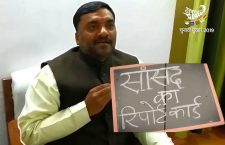Examining the taboos around male vasectomy, from rural Mahoba
“I kept having children in short periods of time,” says Mankunwar bashfully, explaining her reasons for having undergone a recent tubectomy. A native of Utiya village in the district of Mahoba, Uttar Pradesh, Mankunwar is a mother of three children and holds her youngest, an infant, in her arms during this interview.
In 2016, the Government of India identified 145 districts in 7 states with high fertility rates to target for better family planning public initiatives. Termed Mission Parivar Vikas, it aims to reduce the total fertility rates (TFR) to 2.1 by 2025 of these seven states using information dissemination, easy access to free contraception like pills and condoms, and incentivizing sterilization methods.
It’s unsurprising that 45 districts from U.P., the most populous state in the country, make the cut for Mission Parivar Vikas. In fact, 11 of them have a TRF of 4 – which means that every woman in the population can or will have 4 children in her lifetime according to existing to existing fertility norms.
Unfortunately, family planning is clouded in myths and taboo. “Using any contraceptive is unnatural,” insists Phoola, who lives in Utiya. Matadeen, another Utiya resident, has a bone to pick with sterilization procedures, “Neither men nor women should get sterilized because it is against the will of God.”
But both the state and central government incentivize sterilization procedures to encourage participation. Women are offered a Rs. 1400 incentive while vasectomies, on the other hand, offer the male participants a Rs. 3000 incentive.
Despite the larger financial gain, men who are willing to undergo vasectomies are few and far in between. A National Health Mission (NHM) report published in 2018 found that out of the 14, 73, 418 sterilization procedures performed in the country between 2017-2018, only 6.8% were vasectomies. The reality of sterilization is even more skewed in UP – NFHS IV found that a staggering 18.1% of all married rural women in U.P. had undergone sterilization, accounting for nearly half of all family planning methods employed by the same demographic—a statistic particularly horrific when compared to the 0.1% of men who had undergone male sterilization. In 2017-2018, there were 3461 vasectomies conducted in UP, which there were 1, 22, 090 tubectomies performed.
Anil Kumari from Mahoba, local ANM worker, outlines the toll that pregnancy can take on a woman, “Women carry the entire mental and physical burden of pregnancy alone.” And shares the various methods that women feel burdened to take on, such as intrauterine devices (IUD), which act as contraceptives, “They often come to me and say, ‘Let’s just get a copper T’. But the men should come forward to take their share of responsibility.” She adds, “But they don’t, and often it’s the wife who refuses to let her husband have it done. It all comes down to a lack of education.”
Asha, another district health worker, says, “2% of all sterilization procedures in the district are vasectomies, the rest are all tubectomies.” She too speaks of wives’ resistance to vasectomies, “They all think that their men will become weak and unable to work,” a concern that stems from the fact that a majority of the employment available in the district is physical labour. “Women consider it their own responsibility,” she explains, “They take on the burden and get tubectomies.”
Sujaan Singh, a medical officer from Mahoba, tells us that that they have been arranging counseling sessions regularly to increase awareness around vasectomies. “Every week in CHCs and PHCs we invite ASHA workers and ANMs to raise awareness about the safety of vasectomies and dismiss the myths about them,” he says, “so that they can increase awareness in the community.” The government has also been known to conduct annual Vasectomy Fortnights in high-focus districts like Mahoba to disseminate information about and encourage vasectomies. And even though their efforts have been constant, says Singh, “We haven’t been able to get many results.”
It has been noted, time and time again, that men refuse to use condoms—the National Family Health Survey IV found that only 7.9% of all married women in rural U.P. have sex where their partners use condoms. Being the most hassle free and easiest option for contraception, willing participation in male sterilization overall, seems like a far-away goal.
This Khabar Lahariya article first appeared on Firstpost.

